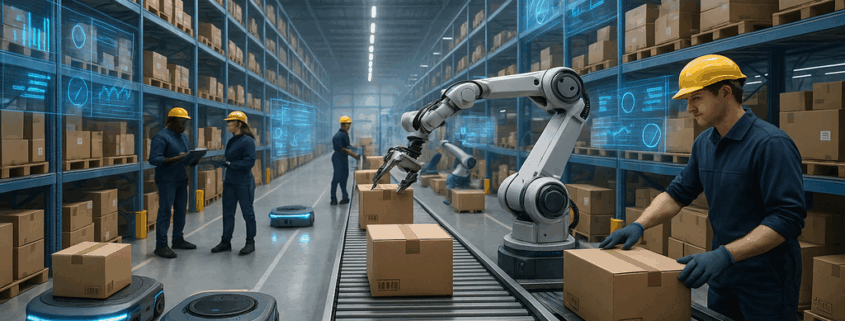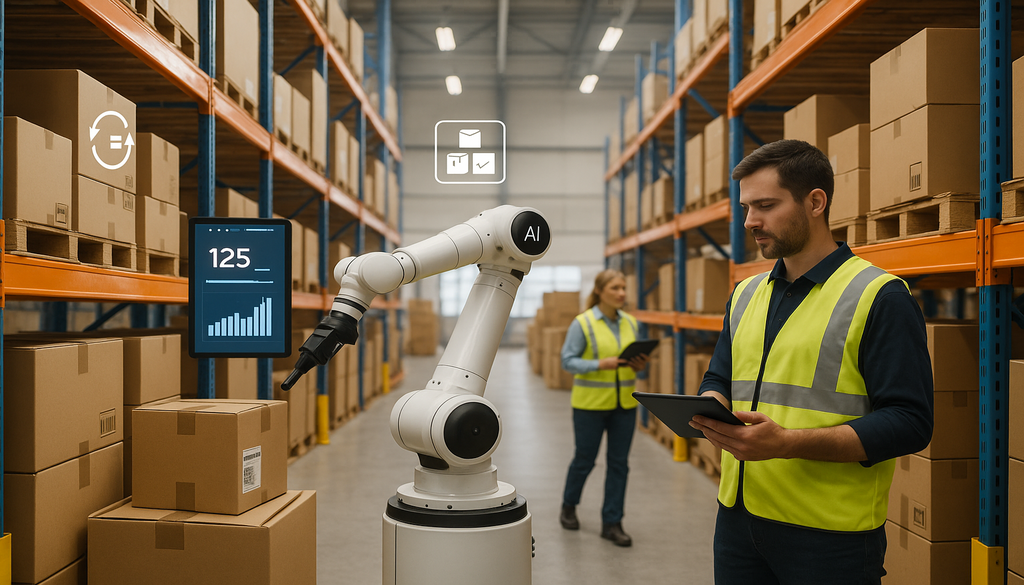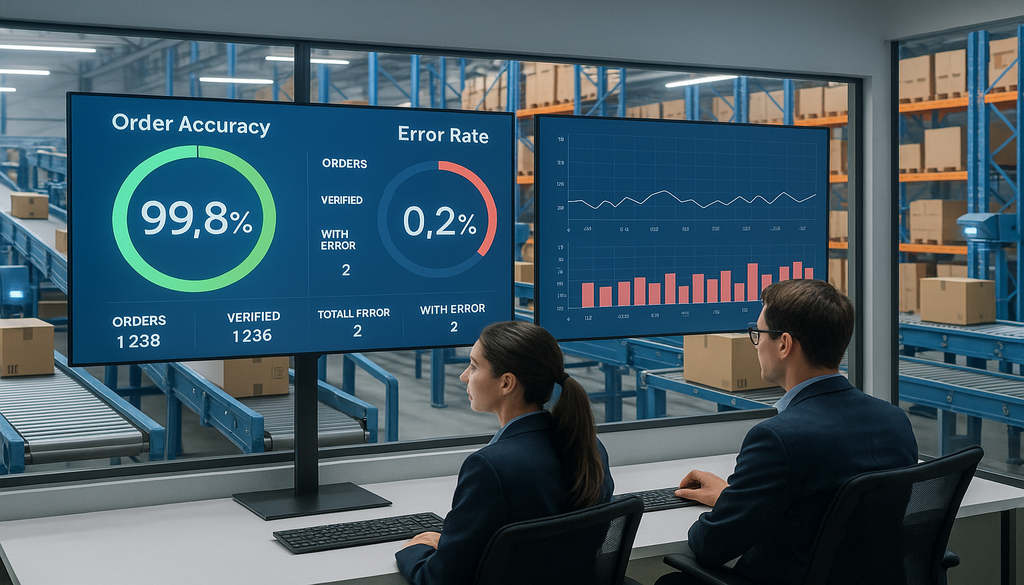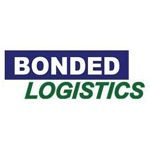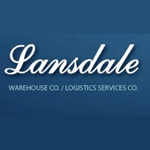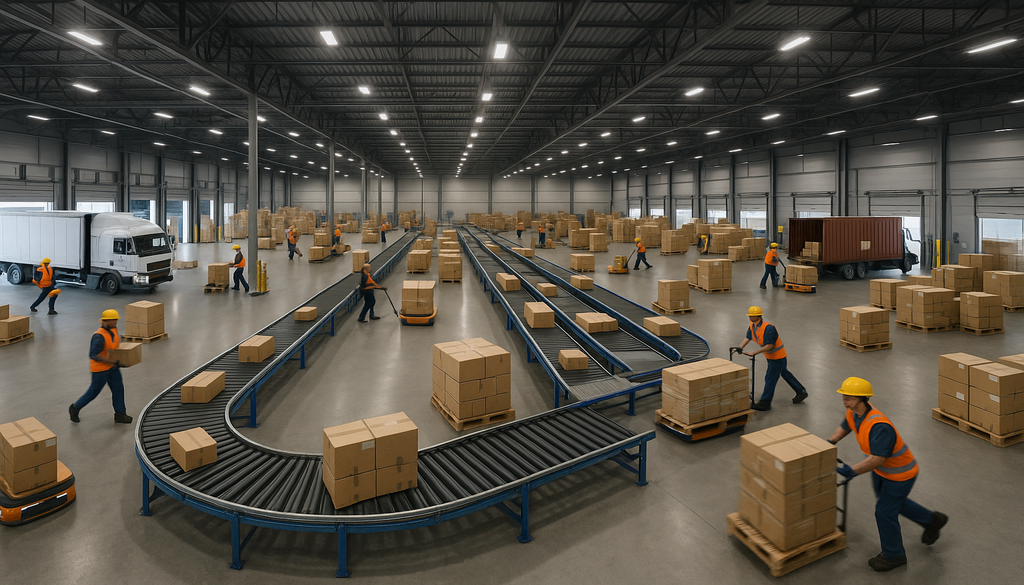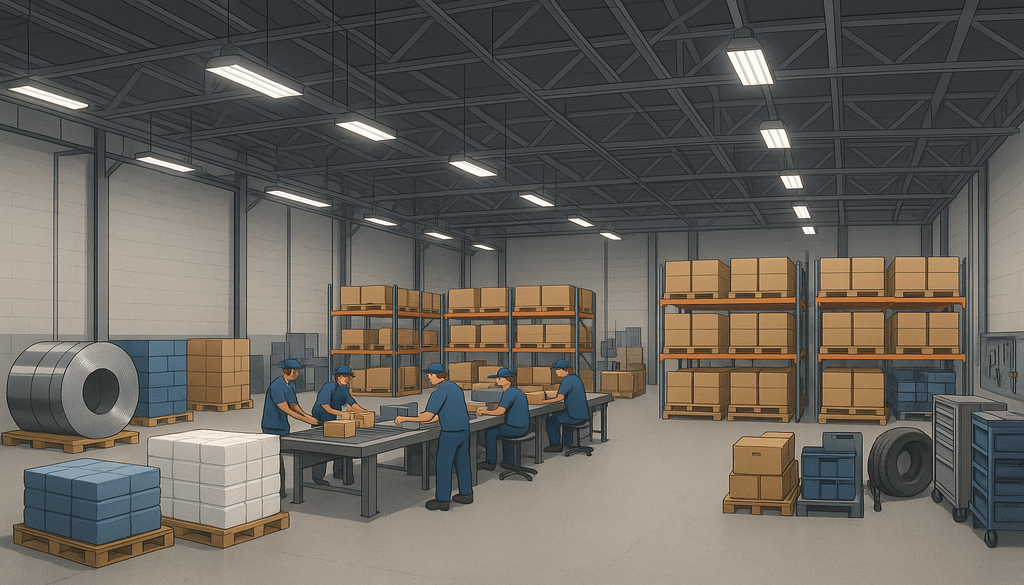7 Smart Ways AI-Led Warehouses Improve High-Volume Fulfillment
The rapid evolution of e-commerce and consumer expectations has placed unprecedented demands on warehouse operations. Today’s fulfillment centers must process orders at lightning speed while maintaining accuracy—a challenge that traditional methods struggle to meet. Enter artificial intelligence, the transformative technology reshaping how warehouses handle high-volume order processing. By leveraging AI capabilities, warehouse operations are becoming smarter, faster, and more efficient than ever before. For supply chain leaders looking to optimize their fulfillment strategies, understanding how AI technologies can enhance warehouse performance is no longer optional—it’s essential for competitive advantage. This article examines seven key ways AI-led warehouses are revolutionizing high-volume order fulfillment and delivering measurable improvements across operations.
Optimizing Inventory Management with AI
Inventory management remains one of the most critical aspects of warehouse operations, with even minor inaccuracies potentially causing major disruptions across the supply chain. AI-powered warehouse management systems address this challenge by continuously monitoring inventory levels and movement patterns, enabling unprecedented accuracy in stock management. These systems utilize machine learning algorithms to analyze historical data, identifying seasonal trends, product correlations, and consumption patterns that might be invisible to human operators. The result is a significant reduction in overstock situations that tie up capital and warehouse space, as well as the elimination of costly stockouts that disappoint customers and damage brand reputation. For warehouse managers, this translates into optimal inventory levels that balance availability against carrying costs while maintaining service levels.
AI solutions also enhance inventory visibility across multiple locations, providing real-time insights into where products are located and their movement status. This comprehensive view allows for more strategic inventory positioning, with fast-moving items placed in optimal picking locations and slow-moving products stored more efficiently. Advanced AI systems can even recommend inventory redistribution across facilities based on regional demand patterns, reducing transportation costs and delivery times. Additionally, these intelligent systems can detect anomalies in inventory data that might indicate theft, damage, or accounting errors, protecting inventory investments and ensuring accuracy in financial reporting.
Automated Replenishment and Reordering
The implementation of AI in inventory management extends to automated replenishment systems that eliminate manual reordering processes. These systems continuously evaluate current inventory levels against forecasted demand, automatically generating purchase orders when stock reaches predetermined thresholds. By removing human intervention from routine reordering tasks, warehouses minimize the risk of human error while freeing staff to focus on more strategic activities. Furthermore, AI systems can optimize order quantities and timing based on supplier lead times, bulk discounts, and storage constraints, ensuring cost-effective replenishment decisions that balance multiple variables simultaneously.
Dynamic Inventory Allocation
For multi-channel retailers, AI offers sophisticated inventory allocation capabilities that optimize stock distribution across sales channels. These systems analyze channel-specific performance metrics, promotional calendars, and seasonal trends to determine the ideal inventory allocation strategy. During peak seasons or promotional periods, AI can dynamically adjust inventory allocations in real-time, ensuring products are available where demand is highest. This intelligent approach to inventory management reduces the risk of channel-specific stockouts while minimizing excess inventory across the network, resulting in improved working capital utilization and higher customer satisfaction levels.
Enhancing Picking and Packing Efficiency
The picking and packing process typically consumes up to 55% of warehouse labor costs, making it a prime target for AI-driven optimization. Artificial intelligence transforms these operations through intelligent route optimization that significantly reduces travel time within the warehouse. AI algorithms analyze warehouse layouts, current order pools, and product locations to create optimized picking paths that minimize the distance traveled by warehouse staff. Some advanced systems incorporate collaborative robots (cobots) that work alongside human pickers, handling the movement between pick locations while employees focus on the actual picking tasks. This human-robot collaboration can increase picking productivity by 200-300% compared to traditional methods, drastically reducing the time required to fulfill orders during high-volume periods.
Beyond route optimization, AI-powered vision systems are revolutionizing the accuracy of picking operations. These systems use cameras and machine learning to verify that the correct items have been picked, providing real-time feedback to operators when discrepancies occur. Some warehouses implement pick-to-light or voice-directed picking systems guided by AI that further reduce error rates while accelerating the picking process. For packing operations, AI determines the optimal packaging configuration for each order, considering factors such as product dimensions, fragility, and shipping costs. This intelligent approach to packaging selection reduces material waste, minimizes dimensional weight charges, and improves the unboxing experience for end customers.
Batch Picking and Sorting Intelligence
AI-driven warehouse management systems excel at creating intelligent batch picking strategies that group similar orders together for more efficient processing. These systems analyze pending orders to identify commonalities in products, shipping destinations, or delivery priorities, then create optimized batches that maximize picker productivity. After batch picking, AI-powered sorting systems automatically distribute products to the correct packing stations or order consolidation areas, eliminating manual sorting steps that can introduce errors. The result is a streamlined workflow that can process significantly more orders per hour than traditional approaches, a critical advantage during peak volume periods when fulfillment capacity is stretched to its limits.
Quality Control and Error Prevention
The final stages of order fulfillment benefit tremendously from AI-powered quality control systems. Computer vision technology can inspect packaged orders to verify contents, check for damage, and ensure proper packaging before shipping. Some advanced systems use weight verification combined with image recognition to confirm that orders contain exactly what they should—nothing more, nothing less. These automated quality checks can be performed in seconds, allowing warehouses to maintain thorough inspection protocols even during the highest volume periods. By catching errors before orders ship, warehouses avoid costly returns, customer dissatisfaction, and the operational burden of processing returned items.
Predictive Analytics for Demand Forecasting
Accurate demand forecasting represents perhaps the most valuable application of AI in warehouse operations. Traditional forecasting methods often struggle with the complexity of modern demand patterns, which can be influenced by countless variables from social media trends to weather conditions. AI-powered predictive analytics overcomes these limitations by processing enormous datasets from multiple sources, identifying subtle correlations that would be impossible for human analysts to detect. These systems incorporate data from historical sales, marketing campaigns, competitor actions, economic indicators, and even social sentiment analysis to generate forecasts with unprecedented accuracy. For warehouse managers, this improved forecasting translates directly into better labor planning, inventory positioning, and resource allocation.
The most sophisticated AI forecasting systems operate at the SKU level rather than broader product categories, enabling micro-segmented demand planning that accounts for individual product nuances. These systems continuously refine their predictions through machine learning, analyzing the accuracy of previous forecasts and adjusting their algorithms accordingly. This self-improving capability means forecast accuracy typically increases over time, creating a virtuous cycle of improved planning and execution. During seasonal peaks or promotional events, AI forecasting provides particular value by helping warehouses anticipate dramatic volume shifts that require temporary staffing adjustments or modified operational procedures.
Labor Force Optimization
With accurate demand forecasts in hand, warehouse managers can optimize their workforce planning with unprecedented precision. AI systems analyze projected order volumes alongside historical productivity metrics to determine exactly how many staff members are needed for each shift and function. This prevents both costly overstaffing during slower periods and service failures due to understaffing during peaks. Some advanced systems even incorporate staff skill profiles and performance data to assign specific individuals to the tasks where they excel, further enhancing overall productivity. For warehouse associates, this intelligent scheduling creates more predictable work patterns and balanced workloads, potentially improving job satisfaction and reducing turnover.
Scenario Planning and Risk Mitigation
Beyond basic forecasting, AI enables sophisticated scenario planning that helps warehouses prepare for multiple potential futures. These systems can simulate various scenarios—such as supply chain disruptions, extreme weather events, or unexpected demand spikes—and recommend contingency plans for each situation. This proactive approach to risk management ensures warehouses remain resilient in the face of uncertainty, with predefined action plans ready to implement when disruptions occur. For high-volume fulfillment operations where even minor disruptions can create major backlogs, this predictive capability provides crucial operational stability and service level protection.
Automated Error Reduction in Order Processing
Human error represents one of the most persistent challenges in warehouse operations, with studies suggesting error rates between 1-3% in manual processes. While this might seem small, in high-volume environments processing thousands of orders daily, even a 1% error rate translates to numerous incorrect shipments and dissatisfied customers. AI-led systems dramatically reduce these errors through automation of verification steps throughout the fulfillment process. From the moment an order enters the system, AI validates its accuracy against inventory availability, shipping restrictions, and fulfillment capabilities. Potential issues are flagged for human review, while straightforward orders proceed seamlessly through the fulfillment workflow. This preventative approach stops errors before they propagate through the system, avoiding costly corrections later in the process.
Order processing accuracy further improves through AI-powered document recognition systems that automatically extract and verify information from purchase orders, invoices, and shipping documents. These systems eliminate manual data entry steps that frequently introduce errors while accelerating the processing of incoming orders. For warehouses handling complex orders with special requirements or customizations, AI can evaluate order specifications against established rules and capabilities, ensuring all special instructions are properly communicated to fulfillment staff. The cumulative effect of these error-reduction mechanisms is a dramatic improvement in order accuracy rates, often exceeding 99.9% in fully optimized AI-led warehouses.
Exception Handling and Resolution
When exceptions do occur, AI systems excel at identifying the most appropriate resolution path based on predefined rules and historical outcomes. Rather than forcing staff to make individual decisions for each exception, AI provides consistent, policy-compliant recommendations that speed resolution while ensuring fairness and consistency. These systems can automatically route exception cases to specialized teams when needed or trigger specific verification procedures based on the nature of the exception. By standardizing exception handling, warehouses not only resolve problems more quickly but also gather valuable data about recurring issues that might indicate opportunities for process improvement or supplier performance discussions.
Customer Communication Intelligence
AI extends error reduction benefits beyond internal operations through intelligent customer communication systems. When potential fulfillment issues arise, these systems can proactively notify customers with transparent updates and resolution timelines, often before customers become aware of any problem. This preemptive communication transforms potentially negative experiences into demonstrations of operational transparency and customer care. Some advanced systems even offer customers AI-powered self-service options for tracking orders, modifying delivery preferences, or initiating returns—all without human intervention from warehouse staff. This combination of error prevention and intelligent communication significantly enhances customer satisfaction while reducing the operational burden of customer service inquiries.
Integration with 3PL and Supply Chain Partners
The modern supply chain extends far beyond the walls of any single warehouse, making seamless integration with third-party logistics (3PL) providers and other supply chain partners essential for optimal performance. AI-led warehouses excel at this integration through intelligent data exchange protocols that ensure information flows smoothly between all parties. These systems synchronize inventory data, order status updates, and shipping information across multiple platforms, eliminating information silos that can lead to coordination failures. For warehouses working with multiple 3PL partners, AI can dynamically allocate orders based on each partner’s current capacity, performance metrics, and geographic advantages, ensuring optimal fulfillment execution regardless of which entity handles the physical processing.
The integration benefits extend to transportation planning, where AI optimizes carrier selection and consolidation opportunities across the entire network. These systems analyze shipping requirements, carrier capabilities, rate structures, and performance history to select the optimal transportation solution for each shipment or group of shipments. For warehouses managing complex distribution networks, AI can coordinate cross-docking operations that minimize handling and storage requirements by synchronizing inbound and outbound movements. This network-wide optimization capability transforms disconnected supply chain components into a cohesive, responsive system that adapts dynamically to changing conditions and requirements.
Collaborative Planning and Forecasting
AI facilitates advanced collaborative planning and forecasting with supply chain partners through shared analytics platforms that provide a single source of truth for all participants. These systems aggregate demand signals from multiple sources, creating consensus forecasts that all partners can use for their operational planning. When forecast adjustments become necessary, AI ensures these changes propagate appropriately throughout the network, maintaining alignment between all parties. This collaborative approach reduces the bullwhip effect that typically amplifies demand variations as they move upstream in the supply chain, creating more stable operations for all participants and reducing costly inventory fluctuations.
Performance Monitoring and Improvement
The integration of AI across supply chain partners creates unprecedented visibility into performance metrics at every stage of the fulfillment process. Warehouses can monitor 3PL performance in real-time, identifying potential service issues before they impact customers. Similarly, 3PLs gain visibility into upcoming demand patterns and special requirements, allowing them to allocate resources appropriately. This transparent performance monitoring establishes accountability while providing the data needed for continuous improvement initiatives. Many AI systems include benchmarking capabilities that compare performance across partners, facilities, or time periods, highlighting best practices that can be shared throughout the network to elevate overall performance.
Real-Time Decision Making and Reporting
Traditional warehouse operations often rely on retrospective reporting that identifies issues only after they’ve impacted performance. AI-led warehouses fundamentally transform this paradigm through real-time analytics and decision support tools that enable immediate action. These systems continuously monitor operational metrics—order processing rates, labor productivity, equipment utilization, quality indicators—and compare them against expectations. When performance deviates from targets, the system immediately alerts relevant managers with not just the problem notification but also recommended solutions based on historical data and predefined response protocols. This real-time visibility empowers warehouse leaders to address issues within minutes rather than discovering them during end-of-shift reviews when correction opportunities have passed.
The reporting capabilities in AI-led warehouses extend beyond basic operational metrics to sophisticated performance visualizations that make complex data instantly comprehensible. Interactive dashboards allow managers to drill down from high-level KPIs to granular details with just a few clicks, identifying the root causes of performance variations. Predictive elements within these reporting systems alert managers to potential future issues based on current trajectories, enabling preemptive action before problems materialize. For executives, AI-powered reporting provides aggregated views across multiple facilities with standardized metrics that facilitate fair comparisons and resource allocation decisions, ensuring capital investments and improvement initiatives target the areas with greatest potential impact.
Dynamic Resource Allocation
The real-time decision capabilities of AI systems enable dynamic resource allocation that optimizes warehouse performance throughout each shift. These systems continuously evaluate work in progress against available resources, automatically adjusting task assignments to balance workloads and eliminate bottlenecks. During unexpected volume spikes, AI can reconfigure picking zones, reassign personnel, or modify batch sizes to maintain throughput without quality compromises. This dynamic approach ensures warehouses maintain optimal productivity regardless of the challenges that emerge during execution, reducing the stress on management teams while improving overall performance consistency.
Continuous Learning and Improvement
Perhaps the most powerful aspect of AI in warehouse decision-making is the continuous learning capability that drives ongoing improvement. These systems analyze the outcomes of previous decisions, identifying which approaches yielded the best results under specific conditions. This learning continuously refines the AI’s recommendation algorithms, making each subsequent decision more effective than the last. For warehouse operations, this creates an environment of perpetual optimization where processes become incrementally better each day without requiring explicit improvement projects. The accumulated effect of these small, continuous improvements often exceeds the impact of traditional large-scale improvement initiatives while requiring less disruptive implementation.
Sustainability and Cost Efficiency Through AI Optimization
The operational benefits of AI in warehousing directly translate to sustainability improvements and cost efficiencies that strengthen bottom-line performance. AI-optimized picking routes minimize travel distance, reducing both labor costs and the energy consumption of material handling equipment. Intelligent inventory management prevents overstocking that would otherwise require climate-controlled storage space and eventually lead to wasteful disposals of obsolete products. Optimized packaging selection reduces material usage while minimizing the dimensional weight of shipments, decreasing both packaging costs and transportation carbon footprint. Collectively, these efficiencies create warehouses that consume fewer resources while processing more orders—a win for both profitability and environmental responsibility.
Energy management represents another area where AI delivers substantial sustainability and cost benefits. Advanced systems monitor energy usage patterns across the facility, automatically adjusting lighting, HVAC, and equipment settings based on occupancy and operational requirements. Some warehouses implement AI-controlled smart grid interactions that shift energy-intensive activities to periods of lower electricity rates or higher renewable energy availability. For cold storage warehouses, AI optimizes defrost cycles and compressor operations to minimize energy consumption while maintaining required temperature ranges. These intelligent energy management capabilities typically reduce warehouse energy costs by 15-30% while advancing corporate sustainability goals through reduced carbon emissions.
Material Flow Optimization
AI extends sustainability benefits through optimization of material flows within the warehouse and throughout the supply chain. Intelligent systems minimize packaging waste by selecting right-sized containers and optimizing fill rates for each shipment. For warehouses handling returns processing, AI identifies opportunities for product reconditioning or component recovery, maximizing the value recaptured from returned merchandise. Advanced systems even analyze transportation networks to identify backhaul opportunities that reduce empty miles, decreasing both shipping costs and transportation emissions. These material flow optimizations reduce waste generation while improving resource utilization, creating more sustainable operations that align with growing corporate environmental commitments.
Long-Term Strategic Planning
Beyond day-to-day optimizations, AI provides valuable insights for long-term sustainability planning in warehouse operations. These systems analyze historical performance data alongside external factors such as energy price trends, regulatory changes, and technology developments to recommend strategic sustainability investments. From identifying optimal locations for solar panel installations to evaluating the ROI of electric vehicle charging infrastructure, AI helps warehouse operators make informed decisions about sustainability initiatives. This data-driven approach ensures sustainability investments deliver meaningful environmental benefits while also strengthening financial performance, creating the business case for continuous improvement in warehouse environmental impact.
Conclusion
The integration of artificial intelligence into warehouse operations represents a fundamental shift in how high-volume order fulfillment can be managed and optimized. From inventory management and picking efficiency to demand forecasting and error reduction, AI delivers improvements across every aspect of warehouse operations. The real-time decision-making capabilities and seamless integration with supply chain partners further enhance these benefits, creating responsive fulfillment networks that adapt continuously to changing conditions. Perhaps most importantly, these operational improvements simultaneously advance sustainability goals and cost efficiency objectives, creating warehouses that perform better across all dimensions of performance.
For supply chain leaders navigating the complexities of modern fulfillment requirements, AI implementation represents not just an opportunity but a competitive necessity. The warehouses that most effectively deploy these technologies will achieve superior service levels, lower operating costs, and greater environmental sustainability—a powerful combination in today’s competitive marketplace. The seven approaches outlined in this article provide a roadmap for warehouse operators seeking to harness the power of AI for high-volume order fulfillment, turning technological possibility into operational reality. By embracing these AI-led strategies, warehouses can transform their operations from reactive to predictive, from labor-intensive to intelligence-driven, and from process-focused to outcome-oriented.
Frequently Asked Questions (FAQ)
Q1: How does AI improve inventory management in high-volume fulfillment centers?
AI significantly enhances inventory management by using algorithms to predict stock levels accurately, automate restocking processes, and identify and rectify discrepancies in real-time. This leads to reduced overstocking or understocking, ensuring optimal inventory levels that align with changing demand patterns, ultimately supporting smoother operations and cost efficiency. Additionally, AI systems can analyze historical data to identify seasonal trends and product correlations, allowing for strategic inventory positioning that reduces handling costs and improves order processing speed. Advanced AI inventory systems can even detect potential supply chain disruptions before they impact operations, enabling proactive mitigation strategies.
Q2: What are the benefits of integrating AI with 3PL in warehouses?
Integrating AI with Third-Party Logistics (3PL) providers in warehouses streamlines communication and data exchange, leading to enhanced logistical efficiency. AI systems analyze vast amounts of data to optimize routes and schedules, predict potential disruptions, and provide actionable insights, which help in making informed decisions that improve service delivery and reduce operational costs. This integration also enables real-time performance monitoring across the entire fulfillment network, creating accountability and visibility that drives continuous improvement. For warehouses managing multiple 3PL relationships, AI can standardize performance metrics and reporting, making partner comparisons more meaningful and facilitating more strategic partnership decisions.

